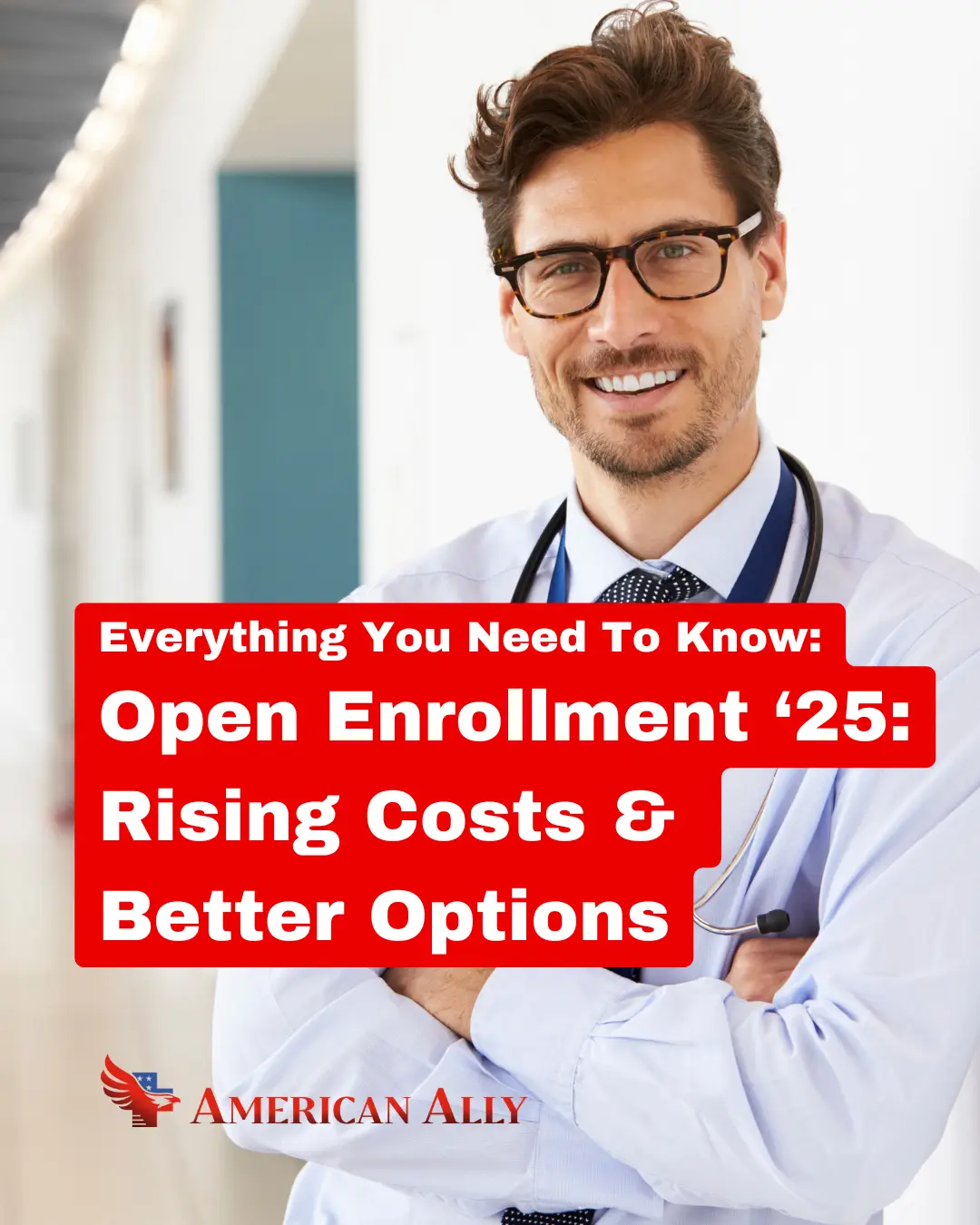Why Teacher Health Insurance is Broken...
And what you can do about it
Every year, educators across the U.S. brace themselves for open enrollment season, when they’re presented with health coverage options that often feel like no choice at all. Whether through TRS ActiveCare in Texas, Georgia’s State Health Benefit Plan (SHBP), Mississippi’s State and School Employees’ Health Insurance Plan, or Florida’s State Group Insurance Program, the reality is the same:
Premiums keep climbing (often $800–$1,200/month for family coverage).
For example, in Texas, the Texas Classroom Teachers Association reports that rates are project to increase for teachers by 9.7% for the 2025-26 plan year.Deductibles can exceed $7,500 before benefits even apply.
Limited HMO Networks leave teachers feeling trapped. (especially if they live on state boarders)
Teachers dedicate their careers to educating the next generation, yet their most essential benefit (teacher health insurance) is increasingly unaffordable and difficult to use.
Teachers across the country are opting out of this no-win scenario and using a simple three-step strategy to save thousands and get access to private PPO coverage for their family!
See How Much This Strategy Could Save You:

The Big Question:
Do Teachers Get Health Insurance Benefits?
The short answer: yes. Teachers typically receive health insurance through state programs like TRS, SHBP, or MyBenefits. But the real problem is that while teacher-only coverage is usually subsidized to make it more affordable, family coverage can be crushingly expensive.
This is why educators are constantly searching for “teachers health insurance benefits” and “what benefits do teachers get?” Teachers get insurance, but the structure leaves many households overpaying for dependents.
What About Substitute Teacher Health Insurance?
Substitute teachers are in an even worse position. Most districts classify them as part-time or contract workers, meaning they are not eligible for state-sponsored coverage. Leaving substitutes turning to the internet to ask: “substitute teacher health insurance” and “do substitute teachers get benefits?”
For substitutes, private PPO plans are often the only affordable path to real coverage.
What Teachers Face Today With State Plans:
Texas Teacher Health Insurance:
TRS ActiveCare
The Texas Teachers Retirement System (TRS) offers TRS ActiveCare for educators. While it provides access to statewide coverage and many districts may subsidize premiums for the teacher, the costs to add family members can be staggering:
Family coverage can start at $1,200+/month.
Deductibles can range from $7,500–$9,100.
Most plans only offer a limited HMO network, (so if you’re traveling or just pick the wrong doctor, you may be out of luck entirely.)
Because of this, TRS health insurance is simply out of reach for many Texas families once dependents are added.
Georgia Teacher Health Insurance:
SHBP
The State Health Benefit Plan (SHBP) covers Georgia educators through Anthem, UnitedHealthcare, and Kaiser options. But like TRS, SHBP may subsidize employee-only coverage while leaving dependent coverage prohibitively expensive.
Many Georgia families face $900+/month for family coverage. Also, limited HMO networks are restrictive, and deductibles can often exceed $5,000.
Mississippi Teacher Health Insurance:
State and School Employees’ Plan
The State and School Employees’ Life and Health Insurance Plan is administered by Blue Cross & Blue Shield of Mississippi. Teachers often benefit from fully subsidized employee-only coverage at the “Base” level, but again, adding dependents is expensive:
Family coverage can range from $800–$1,000/month.
Limited HMO networks, leave families with fewer provider options.
Deductibles and copays apply before meaningful coverage kicks in.
This is why Mississippi teachers continually search for alternatives to their state plan each year.
Florida Teacher Health Insurance:
State Group Insurance Program
Florida educators fall under the State Group Insurance Program, offering Florida Blue PPO and HMO options. Like other states:
Employee-only coverage may be subsidized for many teachers.
Dependents can cost $600–$1,200/month.
PPO access is increasingly restricted.
Florida teachers often ask, “Is there a better option than MyBenefits?”
The #1 Teacher Health Insurance Strategy:
After helping thousands of teachers review their coverage, we’ve found one strategy consistently saves the most:
- Keep your subsidized teacher plan for yourself: Only if your district is offering an affordable employee-only coverage rate.
- Switch your spouse and kids to a private PPO plan: This is where the real savings are. Child-only plans or Spouse + Children plans are often incredibly affordable and offer better benefits than those state plans.
- Get real, usable benefits: Your family can save even more on a plan with $0 copays, $0 outpatient deductibles, up to 20 doctors visits per person, per year, and nationwide PPO access.
This approach lets you keep the subsidy while avoiding inflated dependent premiums.
It works in Texas, Georgia, Mississippi, Florida, and beyond.
How This Teacher Health Insurance Strategy Works:
Step 1: Keep Your Teacher Plan
Find out if your district subsidizes your TRS, SHBP, or MyBenefits employee-only plan. (if your not sure how to find out, give us a call; our experts can help you find out!) A Texas teacher might pay $20/month for individual TRS coverage and that’s worth keeping.
Step 2: Switch Your Family to Private PPO Coverage
Private PPO plans, like American Ally offers, are available for child-only or spouse+children and come with benefits like:
- $0 copays for doctor, urgent care, specialist, and ER visits
- $0 outpatient deductibles (day-one usable benefits)
- Up to 20 doctor visits per year per person: for a spouse and 2 kids, that’s 60 doctors visits (chiropractic included)
- Nationwide PPO access.
Step 3: Add Year-Round Advocacy Support
American Ally’s Advocacy Membership provides:
- Pre-pricing for procedures
- Post-bill negotiation (often erasing inflated charges)
- Claims support and network provider lookups
This makes using your health insurance easy and ensures that you never have to navigate the US healthcare system alone.
I spoke with a licensed agent who showed me how I could stay on my TRS plan for about $19/month—and move my husband and kids to a more affordable private plan.
That one change saved us over $650/month—more than $7,000 a year back in our pocket."
(*Name and identifying details changed for privacy.)
See How Much This Strategy Could Save You:

Why This Teacher
Health Insurance Strategy Works
Keeps subsidized individual coverage in place.
Cuts out costly dependent premiums.
Provides better everyday benefits than TRS, SHBP, or marketplace options.
Works nationwide, so coverage travels with families and allows you to see doctors across state lines.
Comparing Teacher Health Insurance:
State Plans vs. Private PPO
| Feature | TRS / SHBP / MS / FL Plans | American Ally Private PPO |
|---|---|---|
| Deductibles | $7,500–$9,100 | $0 outpatient |
| Copays | $20–$40+ | $0 |
| Network | Restricted HMO/PPO | Nationwide PPO |
| Advocacy Support | None | Pre-pricing, claims, bill negotiation |
Undoubtedly this comparison makes it obvious why thousands of teachers are switching.
Teacher Health Insurance FAQs
Do teachers get health insurance?
What benefits do teachers get?
Beyond health insurance, teachers may receive pensions, sick leave, and additional benefits such as dental and vision coverage. Still, health insurance is often the most costly and important part of their benefits package, making it a key factor in household budgets.
Do substitute teachers get health insurance?
When is open enrollment for teachers in 2025?
Open enrollment periods vary by state and district. In Texas, TRS ActiveCare typically runs from early July through mid-August (TRS). Georgia’s SHBP generally runs in October (Georgia SHBP). Florida and Mississippi districts also hold their open enrollment in the fall, often between mid-September and late October. Missing these windows may lock teachers into their current plan for the year.
What is the cheapest insurance for teachers?
If a district pays toward the teacher’s own premium but not dependents, many families find it can be more affordable to keep the teacher on the district or state plan and move dependents onto a private PPO plan. This strategy may save families thousands annually while still ensuring nationwide access and usable benefits.
Is TRS health insurance good?
TRS ActiveCare in Texas can be affordable for employee-only coverage when districts subsidize premiums. However, many families find that TRS family coverage is very expensive, with premiums often over $1,800 per month. This is why some teachers explore private alternatives that could lower costs.
How much do Florida teachers pay for health insurance?
Costs in Florida can vary by district, plan type, and family size. Many teachers note that family coverage may be a substantial monthly cost, while employee-only coverage is often more manageable if the district contributes. Checking local benefits alongside private plan options helps many teachers find what works best.
How much do Georgia teachers pay for health insurance?
Georgia teachers are typically covered through the State Health Benefit Plan (SHBP). Premiums may differ depending on plan choice and coverage level, and many educators find that family premiums can be high compared to employee-only coverage. Reviewing SHBP plans and comparing them with private options may help families lower their overall costs.
How much do Mississippi teachers pay for health insurance?
In Mississippi, premiums can vary by district and plan. Many teachers say that family coverage could be a large share of their income, while employee-only coverage may be more affordable when contributions apply. Teachers often compare district offerings with private PPO plans to find an option that may reduce expenses.
Open Enrollment 2025:
Why Teachers Should Act Before They're Stuck
Every year, teachers face critical health coverage decisions during their open enrollment.
Here’s what you need to know for 2025:
Texas (TRS ActiveCare): Enrollment windows fall in the Summer. TRS requires educators to select coverage for the entire year, locking in expensive dependent premiums unless you opt out.
Mississippi (State and School Employees’ Health Insurance Plan): Open enrollment typically runs October 1–31. Teachers who miss this window are stuck with current coverage for another year… regardless of cost.
Georgia (State Health Benefit Plan – SHBP): Open enrollment typically occurs in October. SHBP offers multiple plan tiers, but dependents usually remain costly no matter which option you choose.
Florida (State Group Insurance Program): Open enrollment is administered via MyBenefits each fall. Choices are limited, and premiums rise nearly every year.
Here’s the catch:
All of these state plans lock you in for 12 months. That means if you choose the wrong benefits or simply stay on an overpriced family plan… you could be out $4,800+ unnecessarily before you get another chance to switch.
The Solution:
Private PPO plans like those offered by American Ally are not tied to open enrollment deadlines. Teachers can enroll anytime, so you don’t have to wait to lock in a better rate!
Teachers deserve affordable health coverage
By combining subsidized individual coverage with private PPOs for dependents, teachers are saving $3,000–$8,000 per year.
The best part? This strategy makes health insurance usable again!
- $0 copays
- $0 outpatient deductibles
- Nationwide PPO coverage
- All backed by advocacy support.
👉 Ready to see how much you can save? Call 1-800-741-6853 today or request a free health insurance quote.
Because at American Ally, we believe:
All Americans deserve affordable healthcare and Teachers deserve an ally.



